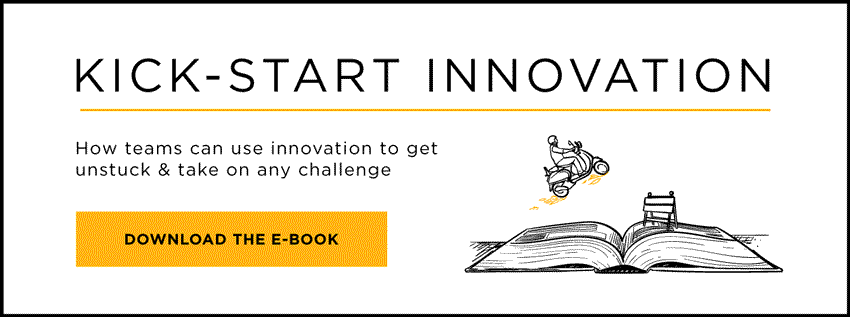 There's a lot of talk about the importance of empowering people to take risks as key to fostering more innovative problem solving in organizations. A cultural shift towards greater autonomy is an important dimension, but a balance must be found or you may discover what a number of other leaders have discovered: pockets of empowered and engaged people working in new and exciting ways, but on challenges that aren't moving the business forward. That’s why strong innovation-focused leaders are so important.
There's a lot of talk about the importance of empowering people to take risks as key to fostering more innovative problem solving in organizations. A cultural shift towards greater autonomy is an important dimension, but a balance must be found or you may discover what a number of other leaders have discovered: pockets of empowered and engaged people working in new and exciting ways, but on challenges that aren't moving the business forward. That’s why strong innovation-focused leaders are so important.
The role of a good leader is to provide direction and to create the conditions for great things to happen. They do that by implementing just enough structure to nudge innovative thinking in the right direction without limiting the ability of their people to take the initiative to generate big ideas and solve problems in new ways.
At ExperiencePoint, we think of this structure along a spectrum between chaos and control. At one end is a chaotic culture, where everyone is fully empowered and encouraged to pursue their own solutions unbounded by the needs of others. In this “high autonomy/low alignment” environment there is plenty of room for big ideas to emerge, but the big ideas may have little to do with the strategic direction of the team or broader organization. As a result people can find their initial excitement turn to dismay when nothing meaningful comes of their efforts.
On the other end of the spectrum is a controlling culture familiar to those with experience working in some large organizations. In the most extreme of these cultures, people have limited-to-no autonomy to make decisions, and are expected to work in lockstep to achieve very specific goals set out by their managers. Progress is constrained in these "low autonomy/high alignment" environments by both the quality of direction and level of engagement. There is little room for creative thinking and risk taking. People feel encumbered and innovative ideas do not emerge.
Finding the balance between the two extremes is how leaders create innovative corporate cultures. The sweet spot is one where team members collaborate and engage fully with the organization's most important challenges. These environments provide the space for human-centered solutions to emerge and delight customers.
Autonomy with Accountability
To achieve this balance, it's helpful for leaders to define work in terms of outcomes or objectives instead of solutions. Objectives help make explicit the most important challenges the organization needs to tackle. Ambitious objectives that stretch people outside their comfort zone encourage impact thinking. The key is to guide people toward solving the right problems without imposing how they might go about doing it.
Strategy can be articulated as a series of cascading objectives — from a top level down to departments, teams and individuals. This ensures that everyone understands how the work they do ties to the broader goals of the business yet gives them freedom to choose how they go about achieving these goals.
Set Direction and Get Out of The Way
Objectives help create the conditions that encourage people to innovate in meaningful ways without too much oversight. Once defined, leaders need to trust people to figure out on their own how they can achieve these goals, and then hold them accountable for the outcomes.
That doesn’t mean every idea has to be a game changer. But it does mean that when people set out to tackle a challenge, it aligns to an objective and they're expected to report on progress, outcomes and lessons learned. Companies like Google and Intel have long used an approach like this, called OKRs, to challenge employees and foster targeted innovation. It is one of the key mechanisms that they use to adapt to a constantly evolving marketplace.
The relentless pace of change that confronts organizations today has many leaders seeking out ways to be more nimble and responsive. An objectives system that enables leaders to re-assess priorities on a quarterly basis and quickly cascade changes is one way to remain agile in the face of change.
You can’t fight the pace of change, but you can keep up with it. We all have more challenges and opportunities than we have the time and resources to tackle them. Being rigorous in identifying the most important priorities and cascading objectives throughout the organization are crucial to empowering employees and creating the conditions for innovative problem solving to flourish.
Learn how to enable innovation skill-building at scale here or download our free ebook Kickstart Innovation: A Guide for Organizations.
James Chisholm is the Co-founder and Principal of ExperiencePoint, a
global business simulation company based in Toronto and San
Francisco. A pioneer in the design of online game-based learning,
James has authored numerous leadership simulations in use by over
100,000 executives and managers worldwide.
James and his team work with senior leaders at organizations
including the United Nations, Google, Microsoft, Exxon Mobil, Bayer,
Nike and various branches of the US Armed Forces. Clients also
include leading business schools such as Wharton, Kellogg, UNC, Mt.
Eliza, HEC (Paris), London Business School, U of Michigan and the
University of Toronto.
James speaks and writes widely on the subject of games, learning and
change. He co-authored chapters in the "Handbook of Experiential
Learning" and in the Center for Creative Leadership’s Fieldbook,
“Experience-Driven Leader Development: Strategies, Tools, and
Practices” (both published by Pfieffer).
